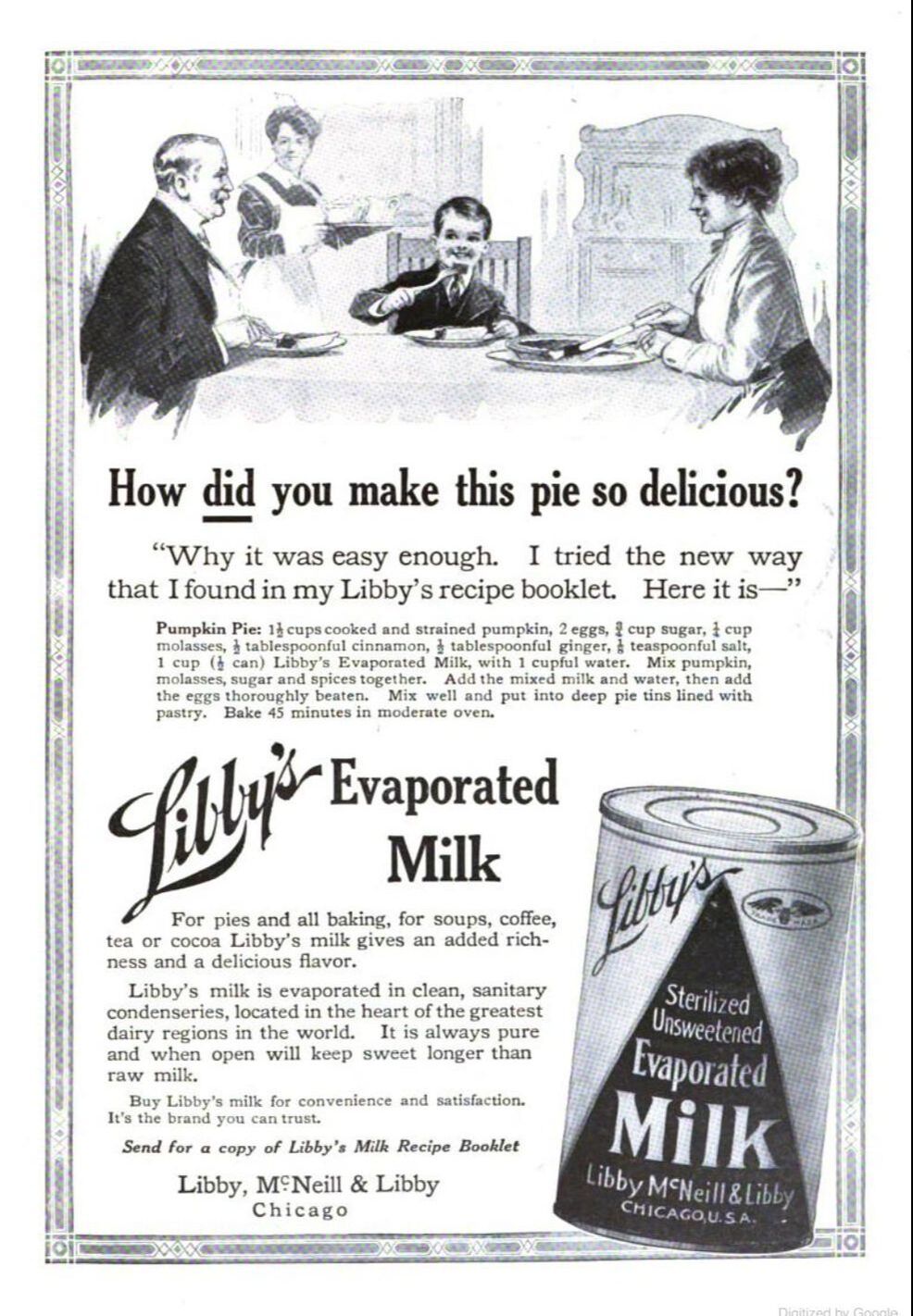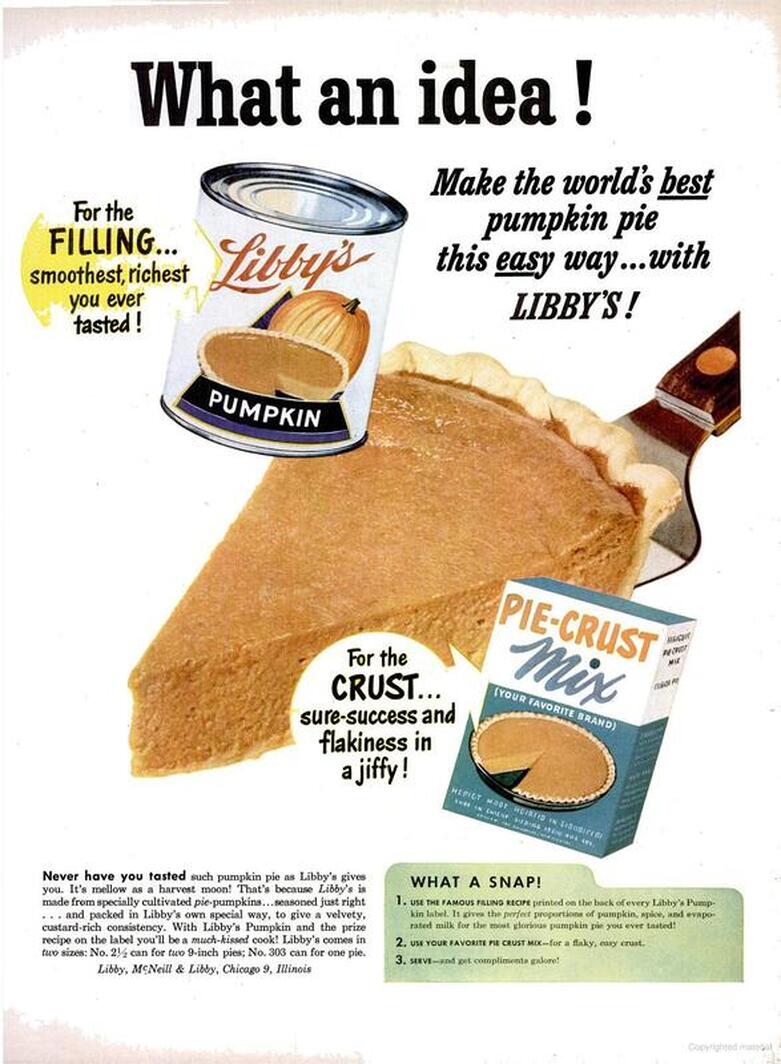|
Libby's pumpkin pie is the iconic recipe that graces many American tables for Thanksgiving each year. Although pumpkin pie goes way back in American history (see my take on Lydia Maria Child's 1832 recipe), canned pumpkin does not. Libby's is perhaps most famous these days for their canned pumpkin, but they started out making canned corned beef in the 1870s (under the name Libby, McNeill, & Libby), using the spare cuts of Chicago's meatpacking district and a distinctive trapezoidal can. They quickly expanded into over a hundred different varieties of canned goods, including, in 1899, canned plum pudding. Although it's not clear exactly when they started canning pumpkin (a 1915 reference lists canned squash as part of their lineup), in 1929 they purchased the Dickinson family canning company, including their famous Dickinson squash, which Libby's still uses exclusively today. In the 1950s, Libby's started printing their famous pumpkin pie recipe on the label of their canned pumpkin. Although it is the recipe that Americans have come to know and love, it's not, in fact, the original recipe. Nor is a 1929 recipe the original. The original Libby's pumpkin pie recipe was much, much earlier. In fact, it may have even predated Libby's canned pumpkin. In 1912, in time for the holiday season, Libby's began publishing full-page ads using their pumpkin pie recipe in several national magazines, including Cosmopolitan, The Century Illustrated, and Sunset. But the key Libby's ingredient wasn't pumpkin at all - it was evaporated milk. Sweetened condensed milk had been invented in the 1850s by Gail Borden in Texas, but unsweetened evaporated milk was invented in the 1880s by John B. Meyenberg and Louis Latzer in Chicago, Illinois. Wartime had made both products incredibly popular - the Civil War popularized condensed milk, and the Spanish American War popularized evaporated milk. Libby's got into both the condensed and evaporated milk markets in 1906. Perhaps competition from other brands like Borden's Eagle, Nestle's Carnation, and PET made Libby's make the pitch for pumpkin pie. Libby's Original 1912 Pumpkin Pie Recipe:The ad features a smiling trio of White people, clearly upper-middle class, or even upper-class, seated around a table. An older gentleman and a smiling young boy dig into slices of pumpkin pie, cut at the table by a not-quite-matronly woman. A maid in uniform brings what appears to be tea service in the background. The advertisement reads: "How did you make this pie so delicious?" "Why it was easy enough. I tried the new way I found in my Libby's recipe booklet. Here it is - " "Pumpkin Pie: 1 ½ cups cooked and strained pumpkin, 2 eggs, ¾ cup sugar, ¼ cup molasses, ½ tablespoonful cinnamon, ½ tablespoonful ginger, 1/8 teaspoonful salt, 1 cup (1/2 can) Libby’s Evaporated Milk, with 1 cupful water. Mix pumpkin, molasses, sugar and spices together. Add the mixed milk and water, then add the eggs thoroughly beaten. Mix well and put into deep pie tins lined with pastry. Bake 45 minutes in a moderate oven. "Libby’s Evaporated Milk "For all pies and baking, for soups, coffee, tea or cocoa Libby’s milk gives an added richness and a delicious flavor. Libby’s milk is evaporate din clean, sanitary condenseries, located in the heart of the greatest dairy regions in the world. It is always pure and when open will keep sweet longer than raw milk. "Buy Libby’s milk for convenience and satisfaction. It’s the brand you can trust. "Send for a copy of Libby’s Milk Recipe Booklet. Libby, McNeill & Libby, Chicago." My research has not been exhaustive, but as far as I can tell, Libby's was the first to develop a recipe for pumpkin pie using evaporated milk. Sadly I have been unable to track down a copy of the 1912 edition of their Milk Recipes Booklet, but if anyone has one, please send a scan of the page featuring the pumpkin pie recipe! Curiously enough, the original 1912 recipe treats the evaporated milk like regular fluid milk, which was a common pumpkin pie ingredient at the time. Instead of just using the evaporated milk as-is, it calls for diluting it with water! The recipe also calls for molasses, and less cinnamon than the 1950s recipe, which also features cloves, which are missing from the 1912 version. Both versions, of course, call for using your own prepared pie crust. Nowadays Libby's recipe calls for using Nestle's Carnation brand evaporated milk - both companies are subsidiaries of ConAgra - and Libby's own canned pumpkin replaced the home-cooked pumpkin after it purchased the Dickinson canning company in 1929. Interestingly, this 1912 version (which presumably is also in Libby's milk recipe booklet) does not show up again in Libby's advertisements. Indeed, pumpkin pie is rarely mentioned at all again in Libby's ads until the 1930s - after it acquires Dickinson. And by the 1950s, the recipe wasn't even making the advertisements - Libby's wanted you to buy their canned pumpkin in order to access it - via the label. The 1950s recipe on the can persisted for decades. But in 2019, Libby's updated their pumpkin pie recipe again. This time, the evaporated milk and sugar have been switched out for sweetened condensed milk and less sugar. As many bakers know, the older recipe was very liquid, which made bringing it to the oven an exercise in balance and steady hands (although really the trick is to pull out the oven rack and then gently move the whole thing back into the oven). This newer recipe makes a thicker filling that is less prone to spillage. Still - many folks prefer the older recipe, especially at Thanksgiving, which is all about nostalgia for so many Americans. I'll admit the original Libby's is hard to beat if you're using canned pumpkin, but Lydia Maria Child's recipe also turned out lovely - just a little more labor intensive. I've even made pumpkin custard without a crust. Are you a fan of pumpkin pie? Do you have a favorite pumpkin pie recipe? Share in the comments, and Happy Thanksgiving! The Food Historian blog is supported by patrons on Patreon! Patrons help keep blog posts like this one free and available to the public. Join us for awesome members-only content like free digitized cookbooks from my personal collection, e-newsletter, and even snail mail from time to time! Don't like Patreon? Leave a tip!
0 Comments
Your comment will be posted after it is approved.
Leave a Reply. |
AuthorSarah Wassberg Johnson has an MA in Public History from the University at Albany and studies early 20th century food history. Archives
July 2024
Categories
All
|




 RSS Feed
RSS Feed